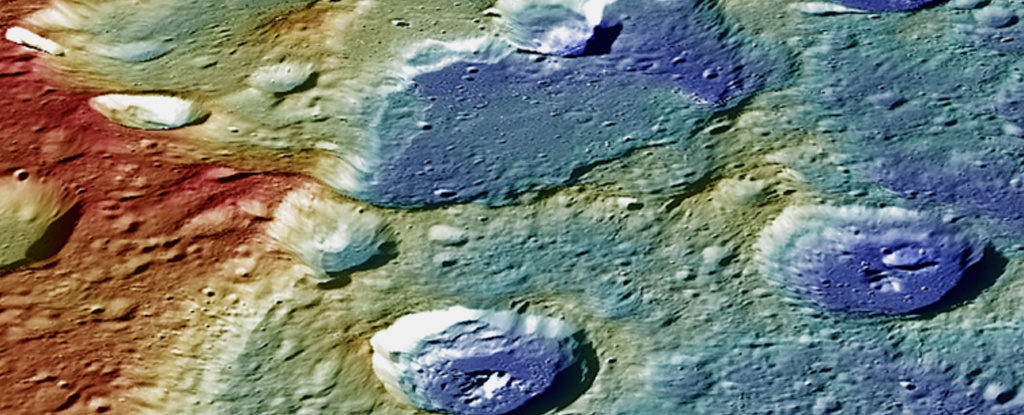Mercury is considered a scorching, barren landscape that would literally melt your face off if you were standing on it in full sunlight. But scientists have also known for a long time that it was shrinking…because it was cold. New research based on distinct features in Mercury’s geography suggests that it might continue to do so even today.
The fact that the hottest planet in the solar system could be shrinking from being cold might sound counterintuitive, but it’s not. Yes, Mercury’s surface is boiling. But the interior isn’t. Much of the heat that hits the surface is radiated away as light, and the material the planet is made out of isn’t a great conductor of heat. As such, the heat from the Sun doesn’t necessarily make it all the way down to Mercury’s core. But the heat that initially resided in the core is still slowly radiating away.
High school chemistry teaches that when temperature decreases, volume decreases. This holds just as much for planets as it does for balloons. So, as Mercury’s interior temperature drops, its volume decreases – in other words, it shrinks. Again, scientists have known this for decades. However, there has been some debate over whether that process is still ongoing.
The debate was fueled by a geological feature called “thrust faults.” These also happen on Earth when one piece of terrain is pushed over another. They typically result in another geological feature known as a lobate scarp, a ramp-like slope that can last for hundreds of kilometers across Mercury’s surface.
Seeing these geological features is helpful for understanding that Mercury has shrunk – by about 7 km according to the best estimates based on data pulled from MESSENGER, one of an earlier set of probes sent to study the planet. However, the features alone don’t do much to provide insight into how long this process has been going on.
Like many other atmosphere-less bodies across the solar system, one way to date geological features is to judge how many craters lie over them. There’s a general consensus on the frequency of asteroid impacts throughout the course of the solar system. However, that frequency varied greatly over time and isn’t necessarily the best way to date these geological features.
Credit – Isaac Arthur YouTube Channel
Original calculations put the scarps at around 3 billion years old; however, it’s unclear if all of the scarps were formed at the same time or if some were formed sooner than others. To answer this question (and thereby get an approximation of whether Mercury is still shrinking or not), graduate student Ben Man from the Open University turned to another geological feature – a “graben.”
In planetary science, a graben is the strip of ground between two parallel fault lines. They are much smaller than the above features – measuring only about a kilometer wide and 100 m deep. However, they can be used to more accurately date things because of yet another geological feature – impact gardening.
Instead of measuring the quantity of craters overlaying a geological feature, impact gardening measures the blurriness of the features in a given area. It assumes that the blurriness is caused by dust that was kicked up from impacts. The blurrier the lines of the feature, the more dust was kicked up on them, and the older the feature was.
Credit – The Geological Society YouTube Channel
After analyzing 48 scarps with these graben features, Mr. Man determined that their average age was about 300 million years old. That’s almost a blink of an eye in geological terms. And since these grabens prove that Mercury is indeed shrinking, it seems pretty clear that the planet is continuing to do so, at least on geological time scales.
No one is sure when humanity will ever be able to experience a “Mercuryquake.” However, the closest planet to the Sun is getting some increased attention lately, with BeppiColombo launching back in 2018 and finally reaching an orbit around Mercury in 2025. Most of the data from these and other studies trying to figure out the geological dynamics of Merucry came from MESSENGER over ten years ago. BeppiColombo will be able to collect much higher quality data than MESSENGER, which might lead to even more insights about this planet of extremes.
Learn More:
David Rothary – Wrinkles on Mercury’s Surface Suggest The Planet Is Still Shrinking
Man et al – Widespread small grabens consistent with recent tectonism on Mercury
UT – Mercury Shrinking: the First Rock from the Sun Contracted More than Once Thought
UT – How Does Mercury Compare to Earth?
Lead Image:
Color-adjusted image of a scarp on Mercury’s surface.
Credit – NASA / John Hopkins University Applied Physics Laboratory / Carnegie Institution of Washington

